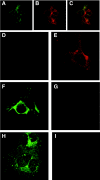The open reading frame 3 gene of hepatitis E virus contains a cis-reactive element and encodes a protein required for infection of macaques
- PMID: 15890906
- PMCID: PMC1112134
- DOI: 10.1128/JVI.79.11.6680-6689.2005
The open reading frame 3 gene of hepatitis E virus contains a cis-reactive element and encodes a protein required for infection of macaques
Abstract
An infectious cDNA clone of hepatitis E virus was mutated in order to prevent synthesis of either open reading frame 2 (ORF2) protein or ORF3 protein. HuH-7 cells transfected with an ORF2-null mutant produced ORF3, and those transfected with an ORF3-null mutant produced ORF2. Silent mutations introduced into a highly conserved nucleotide sequence in the ORF3 coding region eliminated the synthesis of both ORF2 and ORF3 proteins, suggesting that it comprised a cis-reactive element. A mutant that was not able to produce ORF3 protein did not produce a detectable infection in rhesus macaques. However, a mutant that encoded an ORF3 protein lacking a phosphorylation site reported to be critical for function was able to replicate its genome in cell culture and to induce viremia and seroconversion in rhesus monkeys, suggesting that phosphorylation of ORF3 protein was not necessary for genome replication or for production of infectious virions.
Figures





Similar articles
-
A PSAP motif in the ORF3 protein of hepatitis E virus is necessary for virion release from infected cells.J Gen Virol. 2011 Feb;92(Pt 2):269-78. doi: 10.1099/vir.0.025791-0. Epub 2010 Nov 10. J Gen Virol. 2011. PMID: 21068219
-
Initiation at the third in-frame AUG codon of open reading frame 3 of the hepatitis E virus is essential for viral infectivity in vivo.J Virol. 2007 Mar;81(6):3018-26. doi: 10.1128/JVI.02259-06. Epub 2007 Jan 3. J Virol. 2007. PMID: 17202216 Free PMC article.
-
Primary structure of open reading frame 2 and 3 of the hepatitis E virus isolated from Morocco.J Med Virol. 1999 Feb;57(2):126-33. J Med Virol. 1999. PMID: 9892396
-
Culture systems for hepatitis E virus.J Gastroenterol. 2013 Feb;48(2):147-58. doi: 10.1007/s00535-012-0682-0. Epub 2012 Oct 27. J Gastroenterol. 2013. PMID: 23104469 Free PMC article. Review.
-
Molecular biology of non-A, non-B hepatitis agents: hepatitis C and hepatitis E viruses.Adv Virus Res. 1991;40:57-102. doi: 10.1016/s0065-3527(08)60277-8. Adv Virus Res. 1991. PMID: 1659777 Review. No abstract available.
Cited by
-
Hepatitis E Virus Mutations: Functional and Clinical Relevance.EBioMedicine. 2016 Sep;11:31-42. doi: 10.1016/j.ebiom.2016.07.039. Epub 2016 Aug 6. EBioMedicine. 2016. PMID: 27528267 Free PMC article. Review.
-
Hepatitis E Virus and Related Viruses in Animals.Transbound Emerg Dis. 2017 Feb;64(1):37-52. doi: 10.1111/tbed.12351. Epub 2015 Apr 27. Transbound Emerg Dis. 2017. PMID: 25919649 Free PMC article. Review.
-
Bats worldwide carry hepatitis E virus-related viruses that form a putative novel genus within the family Hepeviridae.J Virol. 2012 Sep;86(17):9134-47. doi: 10.1128/JVI.00800-12. Epub 2012 Jun 13. J Virol. 2012. PMID: 22696648 Free PMC article.
-
Advances in Hepatitis E Virus Biology and Pathogenesis.Viruses. 2021 Feb 9;13(2):267. doi: 10.3390/v13020267. Viruses. 2021. PMID: 33572257 Free PMC article. Review.
-
An essential RNA element resides in a central region of hepatitis E virus ORF2.J Gen Virol. 2013 Jul;94(Pt 7):1468-1476. doi: 10.1099/vir.0.051870-0. Epub 2013 Mar 20. J Gen Virol. 2013. PMID: 23515023 Free PMC article.
References
-
- Emerson, S. U., M. Zhang, X. J. Meng, H. Nguyen, M. St. Claire, S. Govindarajan, Y. K. Huang, and R. H. Purcell. 2001. Recombinant hepatitis E virus genomes infectious for primates: importance of capping and discovery of a cis-reactive element. Proc. Natl. Acad. Sci. USA 98:15270-15275. - PMC - PubMed
MeSH terms
Substances
LinkOut - more resources
Full Text Sources

